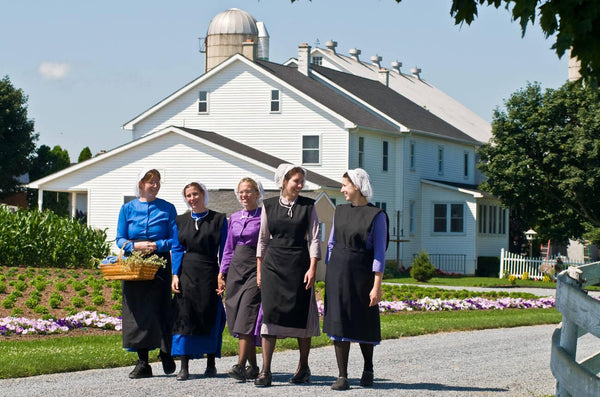Belonging is something every human being strives for, but some situations are simply unsuited for certain individuals. Usually, that means moving out or trying out a new town.
But what happens when an Amish person leaves the community?
It’s a fascinating question, especially considering the unique and rich culture of the Amish people. The Amish are so notoriously tight-knit that it’s hard to imagine what happens when someone opts to leave it behind.
In this piece, we’ll look at the reasons, the process, and the problems that come with making a choice that changes your whole life. You’re more than welcome to share the insights we’ve gathered from our extensive experience with Amish culture.
So, grab a cup of tea, settle in, and join us as we explore this captivating aspect of the Amish way of life!
What this article covers:
- Why Do People Leave Amish Communities?
- The Process of Leaving the Amish Community
- Challenges Faced After Leaving the Amish Community
- Maintaining Ties with the Amish Community
Why Do People Leave Amish Communities?
The reasons for Amish leaving home are as diverse as the individuals themselves. Each journey is unique, and understanding the factors that contribute to Amish people leaving can provide a clearer picture of the challenges they face and the courage it takes to embark on such a path. Here are some of the most common reasons that can cause someone to leave the Amish community.

Pursuit of Personal Goals and Dreams
It’s not uncommon for Amish individuals to have aspirations that extend beyond the boundaries of their community. From pursuing higher education to launching a career in a non-Amish field, these personal goals can be a powerful driving force behind their decision to leave.
The concept of self-actualization isn’t explored very heavily in Amish culture, but it’s the highest level of Maslow’s hierarchy of needs for a reason. While the Amish commit to putting the Lord’s will above all else, there are plenty of Christians who believe they can do that while achieving personal satisfaction and actualization.
If one’s personal goals cannot be achieved within the confines of the Amish lifestyle, it can lead to resentment over time and may lead some to leave their community.
Desire for a Different Lifestyle
The Amish way of life is steeped in tradition and rooted in simplicity. For some, the appeal of modern conveniences, social experiences, or even fashion can be too enticing to ignore.
It’s important to remember that the Amish are just like anyone else, with individual tastes and preferences. When these preferences no longer align with their community’s expectations, it can lead to an individual leaving the community.

Exposure to the Outside World through Technology
While many Amish communities shun modern technology, the reality is that some Amish individuals will come into contact with the wider world through various means. This exposure can spark curiosity and a desire to experience life beyond the community’s boundaries.
In each of these cases, the decision to leave home is rarely taken lightly. It often involves significant soul-searching and weighing the potential consequences of stepping away from the familiar. But, as we’ll see in the following sections, Amish people leaving their communities can face numerous challenges as well as opportunities for personal growth and fulfillment.
The Process of Leaving the Amish Community
The process of leaving the Amish community can be as intricate as the beautiful handwoven Easter baskets they create, with multiple steps and considerations involved. It’s not as simple as just packing up a bread box and pie carrier and heading out into the world. Here’s an overview of the journey that Amish individuals might undertake when leaving their community:
Rumspringa
Rumspringa, also known as the Amish teenage break, is a period of exploration and self-discovery for Amish teenagers. It’s a crucial time when they can experience life outside the community.
During this period, they can decide whether to commit to the Amish church and its way of life or to pursue a different path.
Keep in mind that not every Amish person who chooses to leave does so during Rumspringa; some may make this decision later in life.
Decision-Making and Family Discussions
We’ve found that leaving the Amish community is rarely a rash decision that’s made overnight. It often involves deep introspection and heavy discussions with family members.
An individual needs to weigh the pros and cons, consider the potential impact on their relationships, and prepare themselves for the challenges that lie ahead.
The Journey Towards Integration into the “English” World
Once the decision to leave has been made, the process of integrating into the modern world begins. This can involve learning a whole host of new skills, like driving a car, navigating technology, and adapting to different social norms. It may also require finding a job, enrolling in school, and even securing housing.
Throughout the whole process, the person leaving the Amish community will probably be in the throes of a mix of emotions, from excitement and anticipation to fear and uncertainty.
The trip can be both thrilling and scary, but it shows how strong and determined the people are who take on this life-changing experience.
It’s also a testament to the conviction of the Amish as a whole. It’s an unenviable situation for the family and friends being left behind. After all, no one wants to be estranged from their loved one, no matter their belief system or upbringing.

Challenges Faced After Leaving the Amish Community
Taking the leap and leaving the Amish community is bold, and those who embark on this journey often face numerous challenges as they adapt to their new life. Here are some of the most common obstacles that individuals may encounter after leaving the community:
Navigating the Modern World
One of the most significant challenges for former Amish individuals is learning to navigate the complexities of the modern world. From mastering technology to understanding the intricacies of urban life, there’s a steep learning curve that can feel overwhelming at times.
However, with determination and a willingness to learn, many people successfully overcome these hurdles.
Establishing New Relationships and Social Networks
Leaving the Amish community often means leaving behind a close-knit network of family and friends. This can be a daunting prospect, but it’s essential for former Amish individuals to build new relationships and social connections in their new environment.
This might involve joining clubs or groups, participating in community events, or simply striking up conversations with neighbors.

Dealing with Misconceptions about the Amish Community
The Amish way of life is often misunderstood or misrepresented in popular culture, which can lead to misconceptions and stereotypes about the community. For those who have left the Amish lifestyle, addressing these misconceptions and sharing their experiences can be both an opportunity and a challenge.
By engaging in open, honest conversations with others, they can help bridge the gap between the Amish and non-Amish worlds.
Adjusting to New Roles and Responsibilities
With the newfound freedom that comes from leaving the Amish community, individuals may find themselves faced with an array of new roles and responsibilities.
From managing finances to making decisions about education and healthcare, they must learn to adapt to a new way of life and take charge of their own destiny.
Despite these challenges, many former Amish individuals demonstrate remarkable resilience and adaptability. They draw strength from their experiences, learn from the obstacles they face, and ultimately forge a new path that is uniquely their own.

Maintaining Ties with the Amish Community
Even after leaving their Amish community, many individuals still feel a strong connection to their roots and strive to maintain ties with their families and friends.
This can be a delicate balance, as they navigate the complexities of blending their new life with their Amish heritage.
Here are some ways in which former Amish individuals might maintain connections with their community:
Regular Visits and Communication
One of the most straightforward ways to maintain ties with the Amish community is through regular visits and communication. Former Amish individuals might travel back to their hometowns to celebrate holidays, attend weddings, or simply spend time with family members.
Although they may face limitations in communication methods, such as the Amish preference for face-to-face conversations or writing letters, these interactions can provide a valuable link to their loved ones.
Preserving Amish Values and Traditions
While embracing the modern world, many former Amish individuals continue to uphold the core values instilled in them by their upbringing, such as humility, hard work, and community.
By incorporating these values into their daily lives, they can maintain a sense of connection to their Amish roots and pass these traditions down to future generations.
Supporting Amish Businesses and Communities
Another way to maintain ties with the Amish community is by supporting Amish businesses and organizations. This might involve purchasing Amish-made products or donating to charities that benefit Amish communities.
These actions not only provide financial support but also help to preserve the rich cultural heritage of the Amish people.

Building Bridges between Amish and Non-Amish Worlds
As former Amish individuals navigate their new lives, they have a unique opportunity to serve as ambassadors between the Amish and non-Amish worlds. By sharing their stories, they can help to foster understanding and appreciation for the Amish way of life, dispel misconceptions, and create connections between the two communities
Conclusion
Exploring the question of “What happens when an Amish person leaves the community?” has led us on a fascinating journey into the lives of those who bravely step beyond the boundaries of their familiar world. As we’ve seen, the decision to leave the Amish community is often driven by personal aspirations and curiosity, but it’s also accompanied by a host of challenges and opportunities for personal growth.
Despite the obstacles they face, former Amish individuals tend to demonstrate incredible resilience and adaptability, drawing upon their rich cultural heritage while embracing their newfound freedom.
Moreover, by maintaining ties with their Amish community, these individuals serve as valuable bridges between two distinct worlds, fostering and facilitating understanding and appreciation for their unique background.
As we celebrate and support the Amish culture, we hope that our exploration of this captivating aspect of the Amish way of life has provided you with a deeper understanding and admiration for these resilient individuals. After all, their stories are a testament to the power of determination, adaptability, and the enduring bonds of family and community.
Did You Find Our Blog Helpful? Then Consider Checking:
- Do the Amish Use Guns
- Do Amish Watch TV
- Amish Computer
- Do Amish Use Tractors
- Amish Internet
- Amish Communication
- Can Amish Fly on Planes
- Can Amish Ride Bikes
- How Do Amish Travel Long Distances
- Can Amish Ride Trains
- Do Amish Drink Alcohol
- Do Amish Drink Coffee
- Do Amish Eat Pork
- Do Amish Go to Doctors
- Amish Health Secrets


